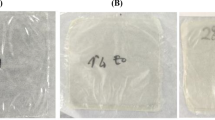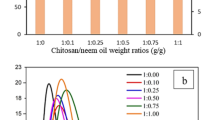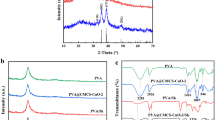Abstract
A novel ultrasound-assisted chitosan–surfactant nanostructure assembly was developed to allow better delivery of chitosan particles into intact fruit tissues for extension of postharvest life. Three solutions of 1 % chitosan–surfactant nanostructure assembly with micelle sizes of 400, 600 and 800 nm were prepared and applied as an edible coating on tomatoes. The fruits were stored at 15 ± 2 °C and 70–80 % relative humidity for 20 days. The indicators of tomato ripening, which included loss of firmness, decline of titratable acidity, decline of chlorophyll content and increase in soluble solid content, were delayed in the treated fruits in comparison to the control (p < 0.05). A delay of approximately 5 days in ripening was observed by evaluating the colour evolution from green to red. The treatment significantly (p < 0.05) enhanced the phenolic content while maintaining a lower level of respiration in comparison to the control, throughout most of the storage duration. However, weight loss was higher in the treated fruits in comparison to the control. No significant difference in the resultant effects was observed by using chitosan–surfactant nanostructure assemblies of different micelle sizes (p > 0.05).








Similar content being viewed by others
References
Ali, A., Maqbool, M., Ramachandran, S., & Alderson, P. (2010). Gum arabic as a novel edible coating for enhancing shelf-life and improving postharvest quality of tomato (Solanum lycoperiscum L) fruit. Postharvest Biology and Technology, 58, 42–47.
Ali, A., Mahmud, T. M. M., Kamaruzaman, S., & Siddiqui, Y. (2011). Effect of chitosan coatings on the physico-chemical characteristics of Eksotika II papaya (Carica papaya L) fruit during cold storage. Food Chemistry, 124, 620–626.
Ali, A., Mahmud, T. M. M., & Siddiqui, Y. (2012). Control of anthracnose by chitosan through stimulation of defence-related enzymes in Eksotika II papaya (Carica papaya L). Journal of Biology and Life Science, 3, 114–126.
AOAC. (2002). Official methods of analysis of AOAC International. Gaithersburg: AOAC International.
Badawy, M. E. I., & Rabea, E. I. (2009). Potential of the biopolymer chitosan with different molecular weights to control postharvest gray mold of tomato fruit. Postharvest Biology and Technology, 51, 110–117.
Chien, P. J., Sheu, F., & Lin, H. R. (2007). Coating citrus (Murcott tangor) fruit with low molecular weight chitosan increases postharvest quality and shelf-life. Food Chemistry, 100, 1160–1164.
Coma, V., Martial-Gros, A., Garreau, S., Copinet, A., Salin, F., & Deschamps, A. (2002). Edible antimicrobial films based on chitosan matrix. Journal of Food Science, 67, 1162–1169.
Fonesca, S. C., Oliveira, F. A. R., & Brecht, J. K. (2002). Modelling respiration rate of fresh fruits and vegetables for modified atmosphere packages: a review. Journal of Food Engineering, 52, 99–119.
Javanmardi, J., & Kubota, C. (2006). Variation of lycopene, antioxidant activity, total soluble solids and weight loss of tomato during postharvest storage. Postharvest Biology and Technology, 41, 151–155.
Lin, D., & Zhao, Y. (2007). Innovation in the development and application of edible coatings for fresh and minimally processed fruits and vegetables. Comprehensive Reviews in Food Science and Food Safety, 6, 60–75.
Maqbool, M., Ali, A., Ramachandran, S., Smith, D. R., & Alderson, P. G. (2010). Control of postharvest anthracnose of banana using a new edible composite coating. Crop Protection, 29, 1136–1141.
McClements, D. J., & Rao, J. (2011). Food-grade nanoemulsions: formulation, fabrication, properties, performance, biological fate and potential toxicity. CRC Critical Reviews in Food Science and Nutrition, 51, 285–330.
Mejia-Torres, S., Vega-Garcia, M., Valverde-Juarez, J., Lopez-Valenzuela, J., & Caro-Corrales, J. (2009). Effect of wax application on the quality, lycopene content and chilling injury of tomato fruit. Journal of Food Quality, 32, 735–746.
Navarro-Tarazaga, M. L., Sothornvit, R., & Perez-Gago, M. B. (2008). Effect of plasticizer type and amount on hydroxyl-propyl methylcellulose-beeswax edible film properties and postharvest quality of coated plums (cv Angeleno). Journal of Agricultural Food Chemistry, 56, 9502–9509.
Pila, N., Gol, N. B., & Rao, T. V. R. (2010). Effect of postharvest treatment on physicochemical characteristics of tomato (Lycoperiscon esculentum Mill) fruits during storage. American-Eurasian Journal of Agricultural and Environmental Science, 9, 470–479.
Porras, M., Solans, C., Gonzalez, C., Martinez, A., Guinart, A., & Guiterrez, J. M. (2004). Studies of formation of W/O nanoemulsions. Colloids and Surfaces A, 249, 115–118.
Qi, L. F., Xu, Z., Jiang, X., Hu, C., & Zou, X. (2004). Preparation and antibacterial activity of chitosan nanoparticles. Carbohydrate Research, 16, 2693–2700.
Qi, L. F., Xu, Z. R., Li, Y., Jiang, X., & Han, X. Y. (2005). In vitro effects of chitosan nanoparticles on proliferation of human gastric carcinoma cell line MGC803 cells. World Journal of Gastroenterology, 11, 5136–5141.
Qi, L. F., Xu, Z., & Chen, M. (2007). In vitro and in vivo suppression of hepatocellular carcinoma growth by chitosan nanoparticles. European Journal of Cancer, 1, 184–193.
Ranganna, S. (1979). Titratable Acidity. In Manual of Analysis of Food and Vegetable Products (pp. 7–8). New Delhi: Tata McGraw Hill Publications.
Romanazzi, G., Karabulut, O. A., & Smilanick, J. L. (2007). Combination of chitosan and ethanol to control postharvest gray mold of table grapes. Postharvest Biology and Technology, 45, 134–140.
Shahidi, F., Arachchi, J. K. V., & Jeon, Y.-J. (1999). Food applications of chitin and chitosan. Trends in Food Science and Technology, 10, 37–51.
Sharma, N., Bansal, M., Visht, S., Sharma, P. K., & Kulkarni, G. T. (2010). Nanoemulsion: a new concept of delivery system. Chronicles of Young Scientists, 1, 2–6.
Singleton, V. L., & Rossi, J. A. (1965). Colorimetry of total phenolics with phosphomolybdic-phosphotungstic acid reagents. American Journal of Enology and Viticulture, 16, 144–158.
Souza, B. W. S., Cerqueira, M. A., Casariego, A., Lima, A. M. P., Teixeira, J. A., & Vicente, A. A. (2009). Effect of moderate electric fields in the permeation properties of chitosan coatings. Food Hydrocolloid, 23, 2110–2115.
Souza, H. K. S., Campina, J. M., Sousa, A. M., Silva, F., & Goncalves, M. P. (2013). Ultrasound-assisted preparation of size-controlled chitosan nanoparticles: characterization and fabrication of transparent biofilms. Food Hydrocolloid, 31, 227–236.
Taghizadeh, M. T., & Abdollahi, R. (2011). Sonolytic, sonocatalytic and sonophotocatalytic degradation of chitosan in the presence of TiO2 particles. Ultrasonics Sonochemistry, 18, 149–157.
Tang, S. Y., & Sivakumar, M. (2012). Design and evaluation of Aspirin-loaded water-in-oil–water nano multiple emulsions prepared using two-step ultrasonic cavitational emulsification technique. Asia-Pacific Journal of Chemical Engineering, 7, 145–156.
Tang, S. Y., Manickam, S., Ng, A. M. H., & Shridharan, P. (2012a). Anti-inflammatory and analgesic activity of novel oral Aspirin-loaded nanoemulsion and nano multiple emulsion formulations generated using ultrasound cavitation. International Journal of Pharmaceutics, 430, 299–306.
Tang, S. Y., Sivakumar, M., Wei, T. K., & Nashiru, B. (2012b). Formulation development and optimization of a novel cremophore EL-based nanoemulsion using ultrasound cavitation. Ultrasonics Sonochemistry, 19(2), 330–45.
Teo, B. X. S., Basri, M., Zakaria, M. R. A., Salleh, A. B., Abdul Rahman, R. N. Z. R. & Abdul Rahman, M. B. (2010). A potential tocopherol acetate loaded palm oil esters-in-water nanoemulsion for nanocosmeceuticals. Journal of Nanobiotechnology, 8, 4. http://www.jnanobiotechnology.com/content/8/1/4.
Traver, T. (2006). Food nanotechnology A scientific status summary synopsis. Food Technology, 60, 22–26.
Valero, D., & Serrano, M. (2010). Postharvest Biology and Technology for Preserving Fruit Quality. Florida: Taylor and Francis Group.
Zahid, N., Ali, A., Manickam, S., Siddiqui, Y., & Maqbool, M. (2012). Potential of chitosan-loaded nanoemulsions to control different Colletotrichum spp and maintain quality of tropical fruits during cold storage. International Journal of Applied Microbiology, 113, 925–939.
Zapata, P. J., Guillen, F., Martinez-Romero, D., Castillo, S., Valero, D., & Serrano, M. (2008). Use of alginate or zein as edible coatings to delay postharvest ripening process and to maintain tomato (Solanum lycoperiscum Mill) quality. Journal of the Science of Food and Agriculture, 88, 1287–1293.
Ziani, K., Fernandez-Pan, I., Royo, M., & Mate, J. I. (2009). Antifungal activity of films and solutions based on chitosan against typical seed fungi. Food Hydrocolloids, 23, 2309–2314.
Acknowledgments
The authors express their gratitude to the Ministry of Agriculture (MOA) Malaysia for the financial support under project grant 05-02-12-SF1003.
Author information
Authors and Affiliations
Corresponding author
Rights and permissions
About this article
Cite this article
Mustafa, M.A., Ali, A., Manickam, S. et al. Ultrasound-Assisted Chitosan–Surfactant Nanostructure Assemblies: Towards Maintaining Postharvest Quality of Tomatoes. Food Bioprocess Technol 7, 2102–2111 (2014). https://doi.org/10.1007/s11947-013-1173-x
Received:
Accepted:
Published:
Issue Date:
DOI: https://doi.org/10.1007/s11947-013-1173-x




